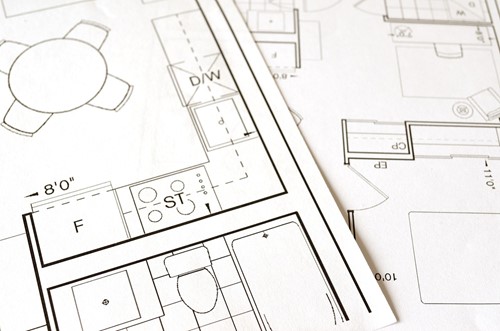
When you look at the plans for your custom home, you might not understand what you’re seeing at first. These plans contain many symbols that can be hard to interpret without architectural knowledge. One of the most common types of symbols that appear on house plans are lines. You might notice several kinds of lines on your house plans, including solid lines, dashed lines, thick lines and thin lines. Learning what these distinct lines mean can help you understand your house plans better.
Solid lines on house plans show visible surfaces or objects, such as windows. Solid single lines on these plans might show cabinet edges, stair edges, window frames or floor edges. These lines indicate edges of different surfaces or objects in your home. You might think of them as boundaries throughout your house. Double solid lines with shading in the middle indicate walls on house plans. If you’re having remodeling or renovating done, you might see new walls shown as double lines with dark gray shading in between, while your current walls will have light gray shading in the middle.
Dashed lines on house plans show objects or surfaces that are overhead but out of view. Keep in mind that house plans usually only show visible objects or surfaces that are up to 4 feet from the floor. Anything above that is considered out of view and represented by dashed lines. Short dashed lines might show objects or surfaces that are just out of view, while long dashed lines might show objects or surfaces that are much higher, such as roof edges. On some house plans, though, such as elevation plans, dashed lines might indicate hidden surfaces or objects, such as shelving inside cabinets and cupboards. Alternating short and long dashed lines are centerlines that show the center of certain objects or fixtures for construction.
House plans might have arced lines or circular lines to show the direction that doors swing open. This helps ensure doors will be able to fully open without hitting anything. These arced lines are usually shown at the end of rectangles on house plans, which represent doors.
The thickness of lines on house plans can indicate the importance of an object or surface or how far away an object or surface is. Thin lines might show objects or surfaces that are farther away or ones that aren’t considered as important as other parts of your home. Thick lines might show objects and surfaces that are closer or ones that are considered more important, such as a wall.
Knowing what each of these lines indicate can make it easier for you to understand what you’re looking at. You can carefully go over your house plans to check for errors or to see if you want to make any modifications or adjustments to them. For example, you might decide that you want to put a window in a room rather than leaving it as a solid wall. You can go over your house plans with your architect or builder to discuss any issues you have or ideas for changes.

I work with all Residential, commercial and industrial. I've helped a lot of my clients sell their properties when they needed to. Buying properties that can close in sooner amount of time. Plotted investments for investors. I have marketing strategies that will help buyers find want they want. Selling strategies that are confirmed well planned out marketing to sell property. Looking forward to meeting all the new potential sellers and buyers.